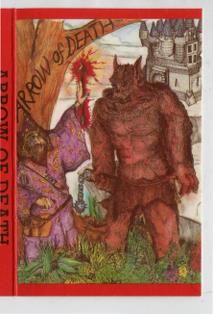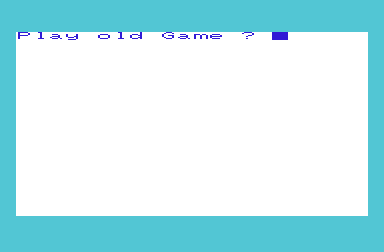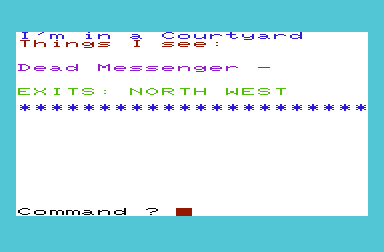Retro Replay Review
Gameplay
Arrow of Death: Part I places you squarely in the tradition of early text adventures, emphasizing careful exploration and inventory-based puzzles over action or combat. You’ll spend much of your time examining locations, picking up key items like the orb, armour, and that fabled eagle, then working out how to use them in the right place. The game world is sprawling, and success depends on methodical mapping and note-taking.
The two-word parser, inherited from the Scott Adams engine, is both a nostalgic charm and a frequent source of frustration. Simple commands like “GET ORB” or “USE ARMOUR” work reliably, but more complex actions can be fiendishly obtuse. You’ll want to experiment with every conceivable verb–noun combination to overcome some of the trickier obstacles, which occasionally leads to frustrating trial-and-error.
Puzzles are firmly rooted in object manipulation rather than combat, making the challenge purely cerebral. There’s no swordplay here—no hit points to manage—instead you’ll solve environmental riddles, unlock hidden passages, and piece together the dreaded Arrow of Death. Fans of classic adventures will appreciate the fair-minded puzzle design, though newcomers may hit dead ends without a hint system.
Progression feels satisfying as each new discovery ties back into Brian Howarth’s overarching Mysterious Adventures series. Although the core gameplay is reminiscent of his previous titles, Arrow of Death ramps up the complexity, demanding sharper observation and more creative item usage. If you relish non-linear problem solving and the thrill of unraveling a medieval mystery by keyboard alone, this installment delivers in spades.
Graphics
As with most Scott Adams engine games, Arrow of Death offers minimal visuals—strictly text descriptions with no in-game artwork. Every location is painted in words, leaving room for your imagination to conjure dark dungeons, ruined temples, and countryside blighted by the evil rays of the tarnished Golden Baton. In that sense, the “graphics” are as rich as your willingness to immerse yourself in narrative prose.
While there are no colorful sprites or animated sequences, the concise descriptions hit just the right note for atmospheric world-building. You’ll read of wilted crops, ominous altars, and hidden compartments with enough detail to feel tangible. The occasional ASCII map or text-based compass directions serve as practical tools, ensuring you always know where you stand even in pitch-black corridors.
For retro enthusiasts, the bare-bones presentation is part of the appeal. Modern gamers accustomed to high-definition visuals may find the absence of graphic flair jarring, but if you prize storytelling and puzzle intricacy over pixel budgets, the sparse interface quickly fades into the background, letting your mind supply the horror and wonder lurking behind every door.
Story
Arrow of Death: Part I picks up the saga after your triumphant recovery of the Golden Baton. Peace should have reigned, but the once-gleaming baton has turned malevolent, poisoning the land with famine and disease. Brian Howarth weaves a dark fairy tale in which your next quest—assembling the legendary Arrow of Death—is the only hope of purging evil from the realm.
The narrative unfolds gradually as you piece together cryptic clues scattered across castles, caves, and ruined temples. Each recovered object—be it the protective armour or that mysterious orb—carries deeper significance, reinforcing the sense of an interconnected world. The inclusion of a carrier eagle adds a magical touch, hinting at ancient rituals and long-forgotten lore.
While there’s minimal character interaction or dialogue, environmental storytelling fills the gap. Descriptions of cartographer’s notes, half-erased wall carvings, and failing crops convey urgency without extended exposition. The lore is neatly embedded within puzzles, ensuring that each breakthrough not only advances gameplay but also deepens your understanding of the kingdom’s plight.
Part I sets the stage brilliantly for the sequel, ending on a tense cliffhanger that promises darker challenges ahead. Though brief by modern standards, the storyline is crafted with care, balancing straightforward objectives with enough mystery to keep you theorizing about the Arrow’s true power and the fate of the land.
Overall Experience
Arrow of Death: Part I is a love letter to the golden age of microcomputer adventures. Its strengths lie in cerebral puzzle design, atmospheric text descriptions, and a tightly woven narrative that rewards patience and perseverance. If you grew up on early 1980s text adventures or have a soft spot for retro gaming, this title will feel instantly familiar—and delightfully challenging.
However, the archaic two-word parser and absence of modern conveniences like autosave or hint systems can be daunting. Occasional parser frustration and lack of hand-holding mean newcomers may need external walkthroughs to progress. That said, overcoming these hurdles offers a genuine sense of accomplishment that polished contemporary games rarely deliver.
Replay value is moderate: once you’ve solved the puzzles, the mystery is revealed and there’s little variation in subsequent runs. Yet, the compact scope makes it perfect for a weekend deep dive into classic adventure tropes. Part I’s cliffhanger ending will leave you eager for Part II, ensuring that devoted players return for the next chapter.
In summary, Arrow of Death: Part I stands as a testament to Brian Howarth’s enduring design flair and the timeless appeal of text adventures. It may not suit everyone—especially those craving flashy graphics or action—but for puzzle aficionados and retro gamers alike, it delivers a rich, immersive experience that harkens back to the genre’s roots.
 Retro Replay Retro Replay gaming reviews, news, emulation, geek stuff and more!
Retro Replay Retro Replay gaming reviews, news, emulation, geek stuff and more!









Reviews
There are no reviews yet.